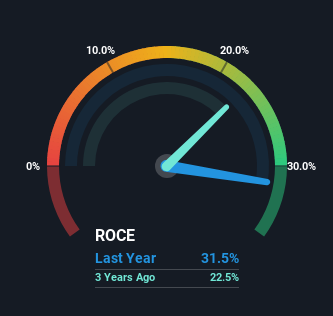- India
- /
- Industrials
- /
- NSEI:3MINDIA
3M India (NSE:3MINDIA) Might Be Having Difficulty Using Its Capital Effectively

Did you know there are some financial metrics that can provide clues of a potential multi-bagger? Amongst other things, we'll want to see two things; firstly, a growing return on capital employed (ROCE) and secondly, an expansion in the company's amount of capital employed. If you see this, it typically means it's a company with a great business model and plenty of profitable reinvestment opportunities. Looking at 3M India (NSE:3MINDIA), it does have a high ROCE right now, but lets see how returns are trending.
Return On Capital Employed (ROCE): What Is It?
For those that aren't sure what ROCE is, it measures the amount of pre-tax profits a company can generate from the capital employed in its business. Analysts use this formula to calculate it for 3M India:
Return on Capital Employed = Earnings Before Interest and Tax (EBIT) ÷ (Total Assets - Current Liabilities)
0.32 = ₹5.5b ÷ (₹27b - ₹9.8b) (Based on the trailing twelve months to March 2023).
Therefore, 3M India has an ROCE of 32%. In absolute terms that's a great return and it's even better than the Industrials industry average of 9.3%.
View our latest analysis for 3M India

Above you can see how the current ROCE for 3M India compares to its prior returns on capital, but there's only so much you can tell from the past. If you'd like, you can check out the forecasts from the analysts covering 3M India here for free.
What Can We Tell From 3M India's ROCE Trend?
When we looked at the ROCE trend at 3M India, we didn't gain much confidence. While it's comforting that the ROCE is high, five years ago it was 42%. However, given capital employed and revenue have both increased it appears that the business is currently pursuing growth, at the consequence of short term returns. And if the increased capital generates additional returns, the business, and thus shareholders, will benefit in the long run.
On a related note, 3M India has decreased its current liabilities to 36% of total assets. So we could link some of this to the decrease in ROCE. Effectively this means their suppliers or short-term creditors are funding less of the business, which reduces some elements of risk. Some would claim this reduces the business' efficiency at generating ROCE since it is now funding more of the operations with its own money.
What We Can Learn From 3M India's ROCE
Even though returns on capital have fallen in the short term, we find it promising that revenue and capital employed have both increased for 3M India. In light of this, the stock has only gained 27% over the last five years. Therefore we'd recommend looking further into this stock to confirm if it has the makings of a good investment.
While 3M India doesn't shine too bright in this respect, it's still worth seeing if the company is trading at attractive prices. You can find that out with our FREE intrinsic value estimation on our platform.
High returns are a key ingredient to strong performance, so check out our free list ofstocks earning high returns on equity with solid balance sheets.
Valuation is complex, but we're here to simplify it.
Discover if 3M India might be undervalued or overvalued with our detailed analysis, featuring fair value estimates, potential risks, dividends, insider trades, and its financial condition.
Access Free AnalysisHave feedback on this article? Concerned about the content? Get in touch with us directly. Alternatively, email editorial-team (at) simplywallst.com.
This article by Simply Wall St is general in nature. We provide commentary based on historical data and analyst forecasts only using an unbiased methodology and our articles are not intended to be financial advice. It does not constitute a recommendation to buy or sell any stock, and does not take account of your objectives, or your financial situation. We aim to bring you long-term focused analysis driven by fundamental data. Note that our analysis may not factor in the latest price-sensitive company announcements or qualitative material. Simply Wall St has no position in any stocks mentioned.
About NSEI:3MINDIA
3M India
Manufactures and trades in various products for the automotive, commercial solutions, consumer markets, design and construction, electronics, energy, health care, manufacturing, safety, and transportation industries in India and internationally.
Flawless balance sheet with reasonable growth potential.
Similar Companies
Market Insights
Community Narratives




